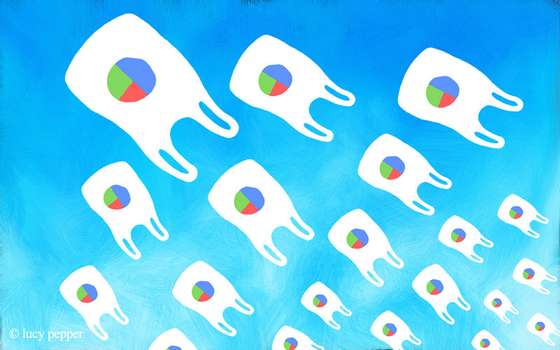No fim de uma semana tão importante para o nosso futuro económico, falei com alguém directamente ligado ao processo.
“Então, quantos sacos plásticos vendeu esta semana?” O rapazinho tímido da caixa do supermercado respondeu-me: “Quase nenhuns”.
Vendeu muitos dos grandes sacos de ráfia, a €0,50 cada um, mas quase nada dos sacos a €0,10 — uma versão mais forte e supostamente mais reutilizável dos sacos antigos.
Mirei as outras caixas. Várias pessoas compravam os sacos de ráfia, e outros tinham-se lembrado de trazer sacos de casa, de modo a evitar pagar os €0,10 por cada saco. Também a mim, como logo anunciei ao miúdo da caixa, me ocorrera trazer um saco de ráfia de casa. No mesmo momento, porém, percebi que não ia ser suficientemente grande para as minhas compras. Ele pôde assim vender mais um saco de ráfia.
Adoro os sacos de ráfia. São bons para levar a roupa para a lavandaria, mudar livros de um sítio para outro, guardar brinquedos ou arrumar papelada que precisa de ser urgentemente tratada durante os próximos dez anos. Tenho centenas deles em casa, vindos dos vários supermercados que frequento. Também tenho vários sacos de pano e armários a rebentar de sacos de plástico dos antigos.
Geralmente, é em casa que ficam, ou, se quando me lembro de os levar à rua, no porta-bagagens do carro. É só quando chego à caixa que costumo lembrar-me de que, mais uma vez, não consegui salvar o planeta, porque deixei os sacos todos em casa ou no carro.
Mas entretanto, o rapaz simpático está-me a dizer, com alegria: “Olhe, a senhora gastou suficiente para receber um saco de ráfia de oferta!”, e tirou mais um saco de debaixo da caixa.
“Ai que bom!”, disse eu a sair do supermercado com 2 novos sacos de ráfia (peso total: 190g de plástico) em vez dos prováveis 3 sacos novos a €0,10, os mais fortes e supostamente mais reutilizáveis (peso total: por volta de 30g de plástico), que podia ter comprado.
A falta de vendas dos novos sacos a €0,10 não vai durar muito, claro. As pessoas vão voltar a comprá-los, talvez dentro de dois meses. Lembram-se da última vez que os supermercados começaram a cobrar €0,02 por cada saco? Durante mais ou menos um mês, houve quem trouxesse sacos de casa, até que finalmente toda a gente passou a comprar os sacos a €0,02.
Por mais que queiramos contribuir para a salvação do planeta com este gesto minúsculo, é difícil. A verdade é que estar à espera que nos lembremos de andar com sacos é simplesmente pedir demais. Mas há mais: as pessoas adoram os sacos de plástico. Que outra coisa podiam usar para separar material para reciclar, levar pequenas quantidades de lixo até o caixote, fazer obras de arte para projectos escolares, meter quantidades enormes de roupa barata, usada só uma vez, para dar a uma instituição, ou até, em alguns poucos casos, pegar na caca do cão?
Segundo as estatísticas, cada um de nós utiliza cerca de 500 sacos de plástico por ano. Se é a verdade, isso significa cerca de 5.000.000.000 (cinco mil milhões) de sacos por ano, só em Portugal.
Espera-se agora que o consumo de sacos de plástico baixe de 500 por pessoa para 50 apenas. É uma perspectiva muito optimista, mas até com 50 sacos a €0,10 por ano, o IVA gerado será de cerca de €10m (e imaginem quanto IVA vão produzir as vendas dos sacos de ráfia, a €0,10 de IVA por saco). Admito, portanto, que isto possa ajudar o défice do orçamento do Estado, embora não muito.
Em termos ambientais, porém, é que me parece que não vai fazer diferença nenhuma. Os sacos de 10 cêntimos, mesmo que haja menos deles, vão também dar jeito como saquinhos de lixo ou para fazer obras de arte nas escolas. E, claro, hão-de acabar também nas florestas e no mar, a esganar e a encher as tripas das criaturas com intolerância ao plástico, e serão muito mais eficazes a matar os bichos, porque são ainda mais fortes e vão levar mais tempo a desfazerem-se.
Mas há ainda outra coisa a ter em mente: é que esses 500.000.000 a 5.000.000.000 sacos são apenas o meio que usamos para transportar vastas quantidades de outras embalagens – em plástico! O plástico utilizado nos sacos de transporte é uma fracção diminuta do total de plástico utilizado nos supermercados, quando comparado com o que serve para embalar os produtos que os sacos transportam até casa. A demonização do saco plástico é ridícula quando temos em conta que a maior parte das coisas que vão dentro dos sacos de plástico estão contidas noutros sacos, em caixas, pacotes ou frascos, que nós não dispensamos, porque nos fazem acreditar que os nossos alimentos nunca foram tocados por mão humana nem nunca estiveram no chão.
A regulação e as nossas manias de segurança e de higiene, sempre a aumentar, tornam impossível que compremos qualquer coisa que não tenha sido selada a calor dentro de várias camadas de plástico, papel ou vidro.
Então, quem é que queremos enganar com a nossa hipócrita fobia do saco plástico? O saco plástico é só 9 gramas da ponta de um enorme icebergue de plástico.
(traduzido do original inglês pela autora)
The plastic iceberg
At the end of this pivotal week, so important in our economic future, I spoke to someone directly involved in the process.
“So, have you sold many plastic bags this week?” I asked the handsome young easy-to-blush man working the checkout in the supermarket.
“Almost none, all week”.
He said he had sold plenty of the big raffia bags, at €0.50 a pop, but barely any of the new €0.10 kind, the slightly stronger, supposedly reusable kind.
I scanned the other tills. There were, indeed, plenty of people buying the big raffia bags, or people who had remembered to bring bags from home to avoid spending €0.10 per bag. I told the young man proudly that I had brought a bag from home, just as I realised that it wasn’t going to be big enough.
He sold me another raffia bag.
I love the raffia bags. They’re great for laundry and moving books and putting toys in and hoarding paperwork that needs to be dealt with sometime in the next ten years. I have several hundred of them at home from most of the supermarkets. I also own several cloth shopping bags and I have cupboards bursting at the hinges with normal plastic bags.
Home is where they usually stay or, if I have remembered to put them there, in the boot of the car. Only when I get to the till do I remember that, while I left home with all the best intentions, I have failed, yet again, to save the planet.
“Oh, look, you have spent enough to have earned a free raffia bag!” the nice young man exclaimed joyfully and he reached under the till for another one.
“Wheeeeee!!” said I as I left the supermarket with two new 2 raffia bags (totalling 190 grams of plastic) instead of what probably would have been 3 new, slightly stronger, supposedly reusable €0.10 plastic bags (totalling about 30 grams of plastic).
The dearth of sales of the new, slightly stronger, supposedly reusable €0.10 plastic bags won’t last, of course. People will be buying them again, soon. I give it about two months this time. Remember when bags started to be charged at €0.02? People brought bags to the supermarket for about a month, before they resumed buying the new ones again.
As much as we want to contribute to saving the world with this one tiny gesture, we just don’t do it. For one, because the act of remembering to take a bag with us is just too much, but worse, people have taken to the plastic bag into their hearts. What else would they use for sorting the recycling, putting the rubbish out, making costumes and artwork for school recycling projects, bagging up vast quantities of cheap clothes that they have worn once and want to give to charity, or even, in some very few cases, oh yes, picking up their dog’s poo?
According to the statistics, we are each still getting through about 500 plastic bags every year. If that’s true, that’s about 50,000,000,000 bags per year in Portugal alone.
It’s hoped that plastic bag consumption will go down from 500 bags per person to about 50. That’s pretty optimistic, but even if the 50 bags @ €0.10 goal is achieved, the VAT generated will be about €10m (and now imagine how much VAT will be generated from sales of the raffia bags, about €0.10 of IVA per bag, because sales of those will rocket too). So, economically, it will be useful, but not exactly debt-busting.
Environmentally, though, let’s face it, this won’t make a blind bit of difference. These heavier plastic bags, although there may be fewer of them in the long run, will still end up as makeshift rubbish bags and school art projects, just more luxurious ones. They will still end up in the forest and the sea, strangling and clogging up the guts of plastic-intolerant creatures, and more effectively too, because they are stronger, so they’ll break down even more slowly.
Worst of all is that those 5,000,000,000 bags are merely used to carry home far larger quantities of packaging. The plastic used in the 5,000,000,000 bags is but a tiny fraction of the plastic used in the rest of the packaging it carries back to our homes, so the demonisation of the plastic bag is preposterous when you consider that most of what goes into it is also bagged, boxed, blister-packed, pretending to have never touched human hand or floor.
Regulation and our ever growing prudishness concerning security and hygiene make it impossible to buy anything that hasn’t been heat sealed under several layers of plastic, paper and glass.
So, whom on our doomed plastic-riddled earth is anyone kidding? The plastic bag is just 9 gram tip of a terrifying plastic iceberg.













